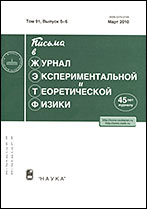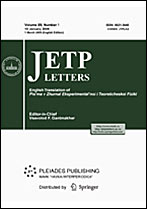|
|
Pis'ma v Zhurnal Èksperimental'noi i Teoreticheskoi Fiziki, 2010, Volume 92, Issue 3, Pages 183–188
(Mi jetpl1376)
|
 |
|
 |
This article is cited in 33 scientific papers (total in 33 papers)
CONDENSED MATTER
On possible deep subsurface states in topological insulators: The PbBi$_4$Te$_7$ system
S. V. Eremeevab, Yu. M. Koroteevb, E. V. Chulkovcd
a Tomsk State University
b Institute of Strength Physics and Materials Science, Siberian Branch of the Russian Academy of Sciences, Tomsk, Russia
c Departamento de Física de Materiales, UPV/EHU, 20080 San Sebastián, Spain
d Donostia International Physics Center (DIPC) and Centro Mixto CSIC–UPV/EHU
Abstract:
Theoretical studies of the bulk and surface electronic structures of PbBi$_4$Te$_7$ are presented. The PbBi$_4$Te$_7$ compound has a layered structure of five-layer (Bi$_2$Te$_3$) and seven-layer (PbBi$_2$Te$_4$) blocks alternating along the hexagonal axis. Analysis of the spin–orbit-induced inversion of the band gap edges indicates that this compound is a three-dimensional topological insulator. The topological properties of this compound are mainly determined by the PbBi2Te4 blocks. The Dirac cone is formed on the PbBi$_4$Te$_7$(0001) surface near the $\bar\Gamma$ point for any block (either Bi$_2$Te$_3$ или PbBi$_2$Te$_4$) forming the surface. It is shown that the Dirac state can be localized not only on the surface but also deeply beneath it.
Received: 21.06.2010
Citation:
S. V. Eremeev, Yu. M. Koroteev, E. V. Chulkov, “On possible deep subsurface states in topological insulators: The PbBi$_4$Te$_7$ system”, Pis'ma v Zh. Èksper. Teoret. Fiz., 92:3 (2010), 183–188; JETP Letters, 92:3 (2010), 161–165
Linking options:
https://www.mathnet.ru/eng/jetpl1376 https://www.mathnet.ru/eng/jetpl/v92/i3/p183
|


| Statistics & downloads: |
| Abstract page: | 429 | | Full-text PDF : | 89 | | References: | 49 |
|





 Contact us:
Contact us: Terms of Use
Terms of Use
 Registration to the website
Registration to the website Logotypes
Logotypes








 Citation in format
Citation in format 
